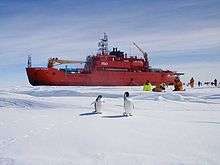Australian Antarctic Division
The Australian Antarctic Division (AAD) is a division of the Department of the Environment. The Division undertakes science programs and research projects to contribute to an understanding of Antarctica and the Southern Ocean. It conducts and supports collaborative research programs with other Australian and international organisations, such as the Bureau of Meteorology and Geoscience Australia, as well as administering and maintaining a presence in Australian Antarctic and sub-Antarctic territories.
Charter
Under its charter the Australian Antarctic Division:
- Administers the Australian Antarctic Territory and the Territory of Heard Island and McDonald Islands
- Conducts research in high priority areas of Antarctic science
- Coordinates and manages Australia's logistic program in Antarctica
- Promotes Antarctic research in universities through grants and the provision of logistic support
- Develops policy proposals and provides advice on Australia's Antarctic interests
- Promotes Australia's Antarctic interests within the Antarctic Treaty System
- Maintains a continuing presence in the region through permanent stations, the establishment of field bases and the provision of transport, communication and medical services
- Acts as the primary source of Australian Antarctic information
Australian Antarctic program
The Australian Antarctic Division leads the Australian Antarctic program (AAp) with four key goals:
- Maintain the Antarctic Treaty System and enhance Australia's influence in it
- Protect the Antarctic environment
- Understand the role of Antarctica in the global climate system
- Undertake scientific work of practical, economic and national significance
Research stations
The AAD headquarters is based in Kingston, Tasmania, just south of Hobart. The division's headquarters houses laboratories for science, electronics and electron microscopy, mechanical and instrument workshops, a krill research aquarium, a herbarium, equipment stores, communications and other operational and support facilities.
The AAD maintains three permanently-manned stations on the Antarctic continent, and one on Macquarie Island in the subantarctic:[1]
- Casey station (including the seasonal camp at Wilkins Runway)
- Davis Station
- Mawson Station
- Macquarie Island station
Remote field bases operate during the summer research season supporting coastal, inland and traverse operations.
Transport

Aviation
The AAD utilises an air transport system, both for transport to and from Antarctica, and for transport within the continent. Aircraft for this system are provided and operated under contract by private sector operators. Services to and from Antarctica are provided, between November and February each year, by an Airbus A319-115LR operated by Skytraders. This aircraft operates to and from the Wilkins ice runway, situated some 65 kilometres (40 mi) from Casey Station.[2][3]
Services within Antarctica are provided by a mixture of fixed-wing aircraft and helicopters. Fixed-wing services are provided by a pair of CASA 212-400 aircraft, equipped with skis, that are also operated by Skytraders. These aircraft operate from Wilkins runway and from smaller snow runways at each of the three permanent stations, as well as any field locations which provide the necessary flat area of snow or ice. Helicopter services are provided by three Eurocopter AS 350 BA Squirrel helicopters, operated by Helicopter Resources.[2][4]
The Antarctic Flight RAAF operated from 1948 to 1963. Since its withdrawal, aircraft from the Royal Australian Air Force operated infrequently in the Antarctic and sub-Antarctic islands in the 1970s and 1980s,[5][6] and more recently in late 2015.[7]
Shipping
The AAD uses the icebreaker RSV Aurora Australis, a multi-purpose marine research and resupply ship chartered from P&O Polar. The Aurora Australis was launched in 1989 and built by Carrington Slipways in Newcastle, New South Wales.[8] In late October 2015 the Australian government announced a plan to acquire a new ice-breaker to replace Aurora Australis by 2019.[9]
Territorial administration
The AAD is responsible, on behalf of the Australian Government, for administering the two Australian federal territories that lie in Antarctic or sub-Antarctic latitudes:
Although the AAD maintains a base on Macquarie Island, that island is not a federal territory but is rather part of the Australian state of Tasmania.
See also
Notes
- ↑ "Stations". Australian Antarctic Division. Archived from the original on 25 October 2010. Retrieved 2010-10-16.
- 1 2 Sebastian, Scmitz (November 2010). "From Oz to Ice: Flight Operations of the Australia Antarctic Division". Airliner World (Key Publishing Ltd).
- ↑ "Aviation". Australian Antarctic Division. Archived from the original on 4 October 2010. Retrieved 2010-10-16.
- ↑ "Intra-continental operations". Australian Antarctic Division. Archived from the original on 29 September 2010. Retrieved 2010-10-16.
- ↑ "Antarctic Flight". RAAF Museum. Archived from the original on 13 June 2010. Retrieved 24 March 2010.
- ↑ Wilson 1991, pp. 110–114.
- ↑ "RAAF operates C-17 proof of concept flights to Antarctica". Australian Aviation. 22 November 2015. Retrieved 14 January 2016.
- ↑ "Aurora Australis". Australian Antarctic Division. Retrieved 2010-10-16.
- ↑ Ikin, Sam; Bolger, Rosemary; Gamenz, Emilie (29 October 2015). "New $500 million icebreaker Australia's biggest investment the Antarctic program, Prime Minister says". ABC News. Retrieved 13 January 2016.
References
- Wilson, David (1991). Alfresco Flight: The RAAF Antarctic Experience. Point Cook, Victoria: Royal Australian Air Force Museum. ISBN 0-642-10522-7.
External links
| Wikimedia Commons has media related to Australian Antarctic Division. |
|